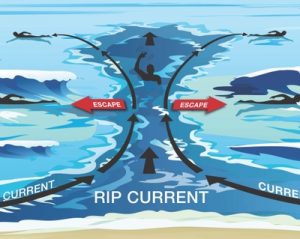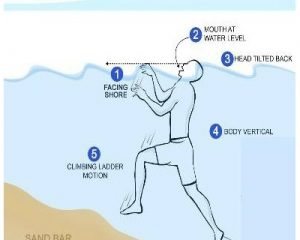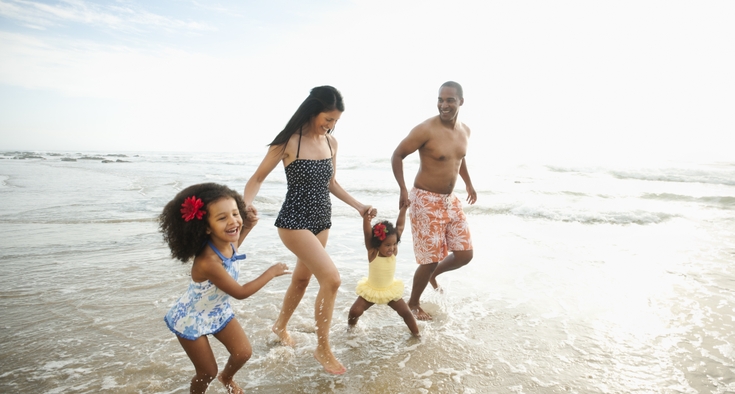Susan Miller, Novant Health Healthy Headlines
To find and book a pediatrician click here.

Drowning is the leading cause of unintentional injury deaths for children ages 1-4 in the U.S., and the third leading cause for children and adolescents ages 5-19, the Children’s Safety Network reports. It’s a scenario that Aaron Kasulis, division chief of emergency medical services (EMS) at Novant Health New Hanover Regional Medical Center, said he sees frequently, especially working on the coast.
Before you swim this summer, read and follow Kasulis’ advice for preventing drowning and water-related injuries.
Introduce your kids to water early
The No. 1 factor that makes drowning more likely is not being able to swim, the U.S. Centers for Disease Control and Prevention reports. Swimming lessons decrease the likelihood of drowning in both children and adults, and lessons can start very young.
“It’s never too early,” Kasulis said. “The sooner the better. Swim instructors will say, even before your children walk, introduce them to water.”
A particularly important part of swimming lessons for children is self-rescue, which teaches children to float on their backs during an aquatic emergency. The CAST Water Safety Foundation states that children as young as 6 months can learn self-rescue swimming and that most children learn how to float on their backs, through formal swimming lessons or play, in one to two months.
Learn essential skills
The American Red Cross advises any swimmer, adult or child, to learn five basic water skills before going swimming for recreation.
These five essential water skills are:
- Entering water that’s over your head and returning to the surface.
- Floating or treading water for one minute.
- Turning over and turning around in the water.
- Swimming at least 25 yards.
- Exiting the water.
To find swimming classes near you, use the Red Cross’ swim lesson provider locator here.
Kasulis said that for beachgoers, the ocean presents an additional set of hazards that everyone should be aware of.
“The ocean is a strong beast,” he said. “There are undertows that you don’t see.”
An undertow is the uprush of water and sand that is generated when a wave breaks. If you’ve ever felt like you were being tumbled roughly underwater while a wave crashed over your head, this was an undertow. Undertows can be especially dangerous to small children who can’t walk toward the beach against a strong backflow and may be pulled underwater.
An additional ocean hazard that every beachgoer should be aware of is rip currents. The National Oceanic and Atmospheric Administration(NOAA) defines a rip current as a powerful, narrow channel of water that moves away from shore at up to 8 feet per second – faster than an Olympic swimmer. Rip currents are common everywhere from the Great Lakes to the Gulf of Mexico, and lifeguards rescue tens of thousands of people from them in the U.S. every year.
The five steps to escaping a rip current are:

- Relax your body and breathe deeply. Rip currents pull you away from shore, but they do not pull you under.
- Do not swim directly toward shore. This is key because the effort will exhaust you.
- Swim parallel to the shoreline until you escape the current’s pull.
- Once you are free from the rip current’s pull, swim at an angle away from the current and toward shore.
- If you feel you can’t swim any further, float on your back facing shore, wave your arms and call for help.
Planning ahead is vital
Knowing how to quickly react with lifesaving tools is key.
“When near-drowning or drownings occur, there’s no time to think,” Kasulis said. “I can’t stress enough that you’ve got to have a plan before you go out and enjoy your day at the beach or at the pool.”
When visiting a public beach or pool, Kasulis advises checking to see when and where lifeguards will be on duty, then swimming in guarded areas. All public pools are regulated, he pointed out, and must have accessible lifesaving devices like rescue cans (foam flotation devices) and rings.
In a pinch, any object that floats and is easy to grip can be used as a flotation device.
“Believe it or not, you can use a cooler that you might have,” Kasulis said. “Dump out the contents, close the lid, and you can throw that out to the person who’s struggling.” Other items that can be used as flotation devices are boogie boards, surfboards, beach balls, innertubes, empty water jugs and basketballs.
For open water activities, life jackets are key. Most states have life jacket laws for children when boating or on a recreational water vehicle, and for states that do not, the U.S. Coast Guard’s interim rule requires children ages 13 and under to wear a life jacket while on a moving boat.
For residential pools, Kasulis recommends having accessible lifesaving tools as well as installing a pool alarm system, which will sound an audible alert if something falls into the water.
‘Reach or throw, don’t go’
Sadly, many drowning deaths happen to the would-be rescuer, Kasulis said.
The Red Cross recommends a “reach or throw, don’t go” approach to helping someone in the water and reminds all swimmers that going into the water to help someone can cause you to get in trouble, too.
Kasulis advises always using a lifesaving tool, such as those listed above, rather than relying on your own swimming abilities to rescue someone.
“Make sure you have some kind of flotation device to go out with you,” Kasulis said. “And that holds true with the pool, no matter how small it is. You still want to have something with you when you go into a pool or the ocean.”
Even for adults who are competent swimmers, Kasulis stressed the importance of never swimming alone and always using a buddy system. He recommends following the example set by surfers, who frequently hang out in groups.
“They look out for each other,” he said.
Recognize the signs of drowning
It’s important to realize what drowning truly looks like, because it’s different from what is portrayed in TV and movies.
“Somebody that’s drowning is not flailing, splashing about and making a lot of noise,” Kasulis said. “When somebody’s truly drowning, it’s really quiet. Their legs and arms are underwater. What happens is they’re trying to stay afloat and they’re trying to catch a breath.”
Other signs of drowning may include:

- Hyperventilating or gasping
- Upright/vertical position in the water, not using the legs
- Glassy, unfocused or closed eyes, or hair covering the eyes
- Head low in the water, the mouth may be underwater or the head may be tilted back with the mouth open
- Inability to respond or say whether they are OK
- Appearance of climbing an invisible ladder
- Trying to swim in a particular direction, but making no progress
Practice constant supervision
Most child drownings occur when adults are present. In fact, 70% of preschoolers who drown are in the presence of one or both parents at the time, Parents Preventing Childhood Drowning reports. This means that most child drownings happen during just a momentary lapse of supervision, not due to a lack of it.
“It only takes not even a second – just a millisecond – that something could happen to your loved one, especially when it comes to small children,” Kasulis said. “That’s a reason that it’s never too early to start teaching and coaching your loved ones about the means of being safe around the water.”
Novant Health
Healthy Headlines
Facebook
Instagram
Twitter
YouTube




